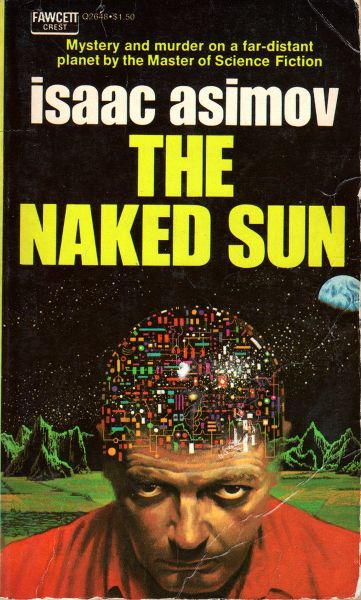Make Me A Robot
The Naked Sun (Robot, volume 2)
By Isaac Asimov

4 Aug, 2024
1957’s The Naked Sun is the second of Isaac Asimov’s science fiction mystery robot novels1.
Having successfully resolved the matter of Spacer Roj Nemennuh Sarton to everyone’s satisfaction (save perhaps Roj), New York police detective Elijah Baley discovers that the reward for accomplishing a difficult task is an even more difficult task.
Summoned to Washington, DC, Plainclothesman Baley discovers he has been assigned another Spacer murder. The last one took him to unfamiliar Spacertown. This new case will send Baley somewhere far more exotic.
But first, some background.
Centuries ago a few Terrans had settled worlds in other solar systems. Thinly populated but far richer than Earth, the Outer Worlds closed the door to immigration. The balance of power strongly favoring the Spacers, Earth can do nothing except accept third rate status and the occasion scrap of charity.
The situation is not stable. Should war break out, Earth would lose badly. It might be entirely depopulated. Undersecretary Albert Minnim is therefore happy to fulfill the Spacer request for a detective to assist with a case on Solaria. It is a unique opportunity to gather information on the Outer Worlds. That Baley does not want the assignment is not a factor. Accompanied by the human-appearing Spacer robot R. Daneel Olivaw, Baley is dispatched across the lightyears.
The Solarian case is both straightforward and perplexing. Rikaine Delmarre was beaten to death. The only other human present was his wife Gladia. As the only other occupants were robots, incapable of harming humans2, Gladia must have killed her husband… except that Gladia was found incapacitated by shock at the murder scene and no weapon was found.
Solaria differs from Earth in ways that have greatly impeded investigation. Earth has eight billion people. Solaria has but twenty thousand. Earth must husband resources carefully and relies almost entirely on human labor. Solaria has an untapped world worth of resources, and legions of robots to manage every task. Earth people live crammed into cities. Solarians prefer solitude, meeting in person only for the unpleasant task of producing more Solarians.
One consequence of the above is that the crime rate is extremely low. Another is that entire occupations are unfilled on Solaria, among them anything resembling police. Thus, the need to ask crime-ridden Earth for assistance when a murder is committed. Thus, as Baley discovers to his displeasure, not just a lack of skills where collecting evidence is concerned, but customs that ensure that evidence is erased by robot cleaners as soon as it is created.
Good news! The killer is not finished with their homicidal crime spree. More evidence is on its way, easy for Baley to collect… as he is one of the targets.
~oOo~
How odd to see nativism as a major background detail in a science fiction novel. I wonder how Asimov, whose family only barely managed to emigrate to the US before the doors were slammed shut, happened to include that element? We shall never know.
Robots are, of course, supposed to be ideal slaves, endlessly loyal and incapable of deliberately harming their owners. Asimov makes sure that readers cannot miss the parallels between robots and human slaves, even adopting terms like “boy” for robot servants. Solarians compare themselves to slave-owning Sparta.
I have long felt that the Three Laws puzzle problems Asimov loved could be seen as the robots screwing with humans, within the constraints allowed by their programming. As this novel makes explicit, the Three Laws do not provide the security humans believe they do, as how they are applied depends on details like what information is available to robots, as well as the definitions given for certain important words.
A pattern I noticed on this rereading: in both The Caves of Steel and The Naked Sun, Baley [rot13 for spoiler] yrgf n xvyyre tb serr. [/rot13] In the first case it is because that solution best serves geopolitical needs. In this case, it’s probably because Baley has the hots for the person in question.
I also noticed that Baley’s methods appear to consist of endlessly antagonizing people, presumably in the hope they will let something slip. Being a lowly Earther as he is, he can hope that the Spacers will underestimate him. It’s a rather Columbo-esque method, but this book was written more than a decade before Columbo first aired.
The mystery isn’t terribly mysterious, aside from the matter of the endlessly vanishing evidence. That’s OK, because the point of the novel is less whodunit than using whydunit to paint a damning picture of Solarian society. While it excels at creating individual wealth, Solarian society is in almost every way pathological. Determined pursuit of isolated lives of endless luxury has produced a planet of intellectually stunted, albeit still dangerous, Eloi, who lack most of the social skills other worlds take for granted3. In many ways, the novel is surprisingly prescient.
The Naked Sun is available here (Amazon US), here (Amazon Canada), here (Amazon UK), here (Apple Books), here (Barnes & Noble), here (Chapters-Indigo), and here (Words Worth Books).
1: The first novel, The Caves of Steel, was reviewed here.
2: Part of Asimov’s motivation in creating the Three Laws was to avoid Frankensteinian cliché. Thus, his robots cannot (easily) kill. In real life, of course, killer robots thrive.
3: How lucky for us that while our social media might encourage similar personal bubbles, the physical world provides reality checks survivors cannot ignore. Although I am sure people will try to do so.
